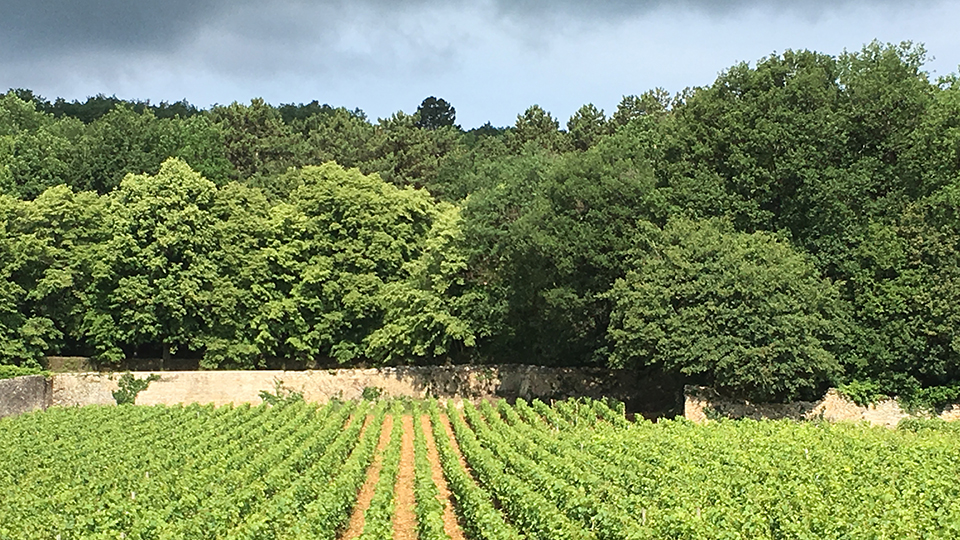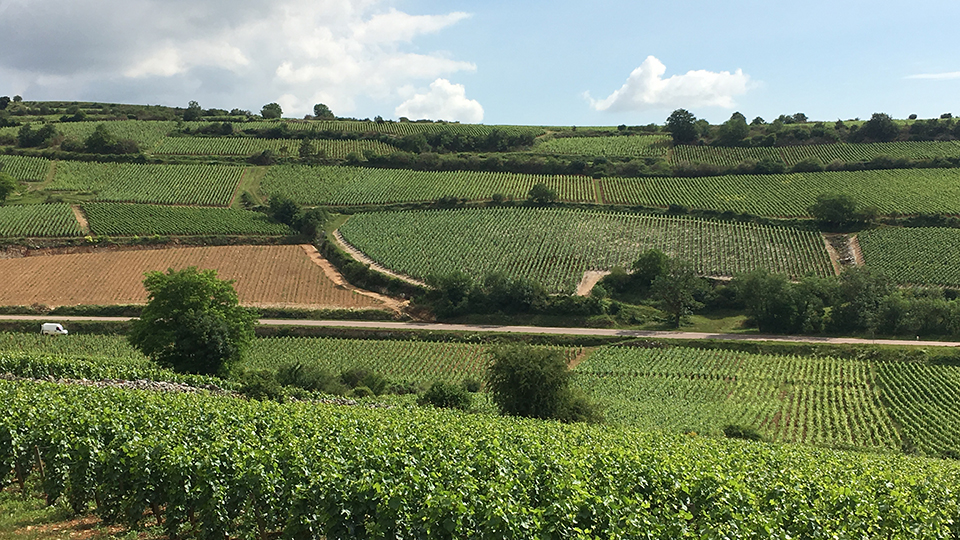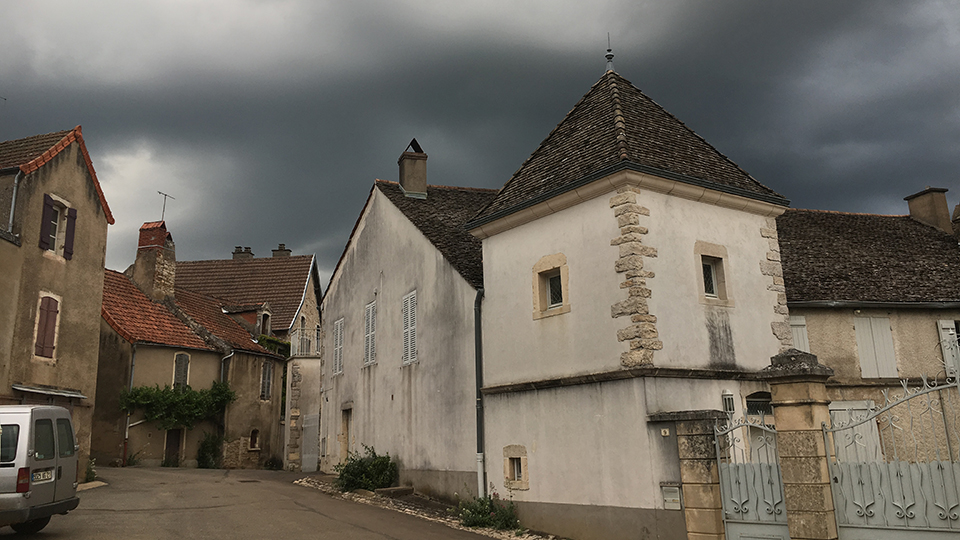Browse using the new Vinous website now. Launch →
Printed by, and for the sole use of . All rights reserved © 2015 Vinous Media
2017 White Burgundy: Quantity, Quality and Great Charm
BY STEPHEN TANZER | SEPTEMBER 6, 2018
The largest white Burgundy crop since 2009 has yielded pliant, elegant, pure wines with considerable aromatic appeal and early accessibility, along with the balance and stuffing for at least mid-term aging.
Nowadays, with climate change triggering extreme weather across the globe on a regular basis, the odds that a growing season in Burgundy will be problem-free seem infinitesimal. Yet although the 2017 season predictably brought its share of challenges, producers on the Côte de Beaune finally made good quantities of wine – the most since 2009. Judging from what I tasted during my annual tour during the end of May and early June, 2017 brought high quality as well. These are pure, easygoing, fruit-driven wines of considerable charm, and a good number of them are more serious than that.

Chassagne-Montrachet Clos Saint-Jean is located at the top of the slope
For Once, the Côte d’Or Was Largely Spared
Burgundy actually benefited from a near-miracle during the second half of April, when nighttime temperatures descended close to, or even slightly below, the freezing mark for 15 consecutive nights, with a low point reached on the night of April 28. This extended cold period, following much warmer-than-normal weather in February, March and the first ten days of April, resulted in widespread frost issues across much of wine-growing Europe – from the right bank of Bordeaux to Switzerland and northern Italy – but largely spared the Côte d’Or (though not Chablis) except for some lower, flatter villages and Bourgogne vineyards where the coldest air settled. (Overall vine yields in France were among the lowest in recent decades in 2017 due to the frost, localized hailstorms, and dry, hot summer weather.)
During the cold period in late April, growers on the Côte d’Or took a number of desperate steps to protect their vines, including burning bales of hay toward dawn to raise the temperature a degree or two and to create a scrim of smoke to soften the morning sunshine, which had burned so many young buds on the morning of April 27, 2016. Domaine Leflaive and its neighbors in Puligny-Montrachet used a helicopter to stir up the air over its vineyards and prevent the frost from settling. Following the disastrous frost of 2016, the Côte d’Or’s (and especially the Côte de Beaune’s) ability to largely dodge frost damage – mostly a matter of luck – was a critical reprieve for many financially strapped estates that have struggled to produce wine in recent years, especially those whose vineyards were hit by hail in 2014, 2013 and/or 2012.
Conditions Were Better Through Late Spring and Summer
After the cold second half of April, temperatures warmed up during the second half of May, and hot, dry weather during the last week of the month and first few days of June resulted in a successful flowering (although numerous growers told me that high temperatures resulted in coulure and smaller berries, and thus reduced the potential size of the crop in some sites). June remained warm and sunny – and especially hot from the 18th through the 27th – but nighttime temperatures were generally moderate. July behaved more normally, with a couple of heat spikes but seasonably cool nights and average rainfall, plus a localized hailstorm on the 10th centered over Morey-Saint-Denis. (On that same day, some of the top crus in Beaujolais – particularly Fleurie and Moulin-à-Vent – suffered much more severe losses to wind-driven hail.)
August was warm again, with some sprinkles of rain during the first three weeks of the month. In the lead-up to the harvest, hot, dry weather dominated from the 22nd through the 29th, and by the end of that period, the earliest pickers on the Côte de Beaune were already in the vineyards. The rest joined them between August 31 and September 6, with most of these growers maintaining that grape sugars were ahead of skin ripeness before that – or even that they needed to wait until acidity levels came down.

Saint-Aubin en Remilly seen from the road through Saint-Aubin Le Charmois
The Harvest Required Careful Picking Decisions
Substantial rain fell on August 30, as much (close to an inch) as the Côte de Beaune had experienced during the entire month up until then. The rainfall interrupted the harvest for the earliest pickers and marked the end of summer heat. After the heat broke on the night of August 29, conditions for the rest of the Chardonnay harvest were more moderate, with afternoon temperatures mostly in the 70s. But there was a bit more rain on September 2, with heavier showers in some spots, then more frequent periods of rain, mostly light, during the second week of the month. By the time heavier rain fell on the 15th and 17th, the Chardonnay was in and even the Pinot Noir harvest on the Côte de Nuits was winding down.
Growers expressed a wide range of opinions on the effects of the August 30 storm. Few estates picked on the afternoon of the 30th or the next day, but much of the crop was harvested during the first week of September. Still, the rainy spells in September hastened the end of the harvest, as growers became unwilling to let their fruit hang any longer for fear of rot – and with heavier rain in the forecast. Some growers maintained that the late-August rain reinvigorated their vines and helped the grapes reach full maturity after the period of heat, while others felt that the precipitation introduced an element of dilution into their wines, especially where crop levels were already high.
A few of the producers I visited maintained that there are really two styles of wine in 2017, one from early-picked fruit with firm acidity and the other from grapes harvested in September under cooler conditions, perhaps with some loss of concentration and acidity. Others were less willing to make generalizations. For example, Jérôme Flous, technical director at Domaine Faiveley, noted that the 2017 whites are “paradoxical in their concentration of fruit balanced by lively acidity. It’s a vintage that showed us that you can pick very early and make a minerally, strong-acid vintage.” For Dominique Lafon, the full crop load in 2017 “turned out to be a positive thing, as the grapes didn’t change as fast or get as high in alcohol” as they otherwise might have in the very warm August conditions. Other growers said that the healthy, thick grape skins also slowed down any swelling of the grapes that might be expected after a period of rain, so that the effects of precipitation were limited.

Glowering two weeks under the threat of violent storms in early June of 2018
In the End, Yields Were Generous but Variable
In many instances, vines whose production had been sharply reduced by frost in 2016 snapped back with a vengeance in 2017, producing copious quantities of fruit and requiring the most conscientious growers to take steps to reduce the number of grapes and clusters. Some producers admitted to making the full permitted yields in 2017 – and their largest crop levels since 2009 – but few thought that yields were excessive for Chardonnay. And Chardonnay yields on the Côte de Beaune were by no means high across the board; in fact, a number of growers told me that their 2017 yields in vineyards that had not been affected by frost in 2016 were actually lower than those of the previous year. (By most accounts, however, Pinot Noir yields, particularly on the Côte de Nuits, were much likelier to be very high, although here, too, yields ranged widely.) Of course Chardonnay is normally much more forgiving of high yields than is Pinot Noir, as well as more likely to be out of whack in years when crop levels are very low due to one extreme weather event or another.
Low acidity in 2017 could prove an Achilles’ heel for some wines, especially those produced from copious yields and late-picked grapes. Total acidity levels at harvest were average at best, but one of the idiosyncrasies of the year was that while malic acidity was often extremely low, having mostly been burned off by summer heat, the more stable tartaric acidity was quite healthy. Most growers would not attempt an explanation for the firm tartaric acidity, but a few attributed it to the dry conditions through most of the summer. In any event, total acidity levels in the grapes did not change dramatically during the malolactic transformations, and post-ML pHs are generally healthy. Most of the ‘17s I tasted from barrel do not lack for vivacity, even if they come across as smoother and easier than the ‘16s.
Grape sugars in 2017 were generally moderate by 21st century standards. Some estates reported a blockage of maturity in their quick-draining hillside sites or young vines with shallow root systems during summer heat spells while others said there was enough moisture in the soil to keep the ripening process going. As a general rule, potential alcohol levels ranged from the low 12s to about 13.5%. The majority of estates I visited chaptalized their wines lightly when their fruit came in with 12.5% or less potential alcohol, but I should note that a growing number of producers these days appear perfectly happy to bottle village wines and premier crus with no more than 13% alcohol. Very few growers reported freakishly high grape sugars in 2017.
The Vinification and the Wines
Most winemakers practiced a gentle extraction with their 2017 whites for fear of throwing their wines off balance, and a number of them cut back somewhat on their use of new oak barrels for the same reason. The fermentations generally went well and, with some exceptions, the malos finished by March or April. While a few of the producers I visited this spring are convinced that their wines will benefit from a leisurely élevage and enrichment on their lees, I suspect most will bottle their wines at their usual times.
For the early pickers, 2017 was frequently a shorter-than-average growing season, with barely 95 days between the flowering and the harvest, as in 2015. Some 2017s, owing to their thick skins or incomplete phenolic ripeness, can show dry tannic edges or slightly herbal qualities but these are the exceptions. The sound levels of tartaric acidity can give some wines a touch of tartness that is not always buffered by fruit sweetness or texture. And Véronique Drouhin noted that “the sometimes high levels of tartaric acidity can also give the wines a more tannic impression – an impression of skins,” adding that that’s why the ‘17s need to be nourished by their lees. The 2017s also appear to possess surprisingly high levels of dry extract for a vintage with mostly generous yields, so it’s possible that this quality is associated with the dusty, sometimes tannic finishes shown by many of the wines. But in the vintage’s better examples, any finishing phenolic harshness is nicely buffered by fleshy fruit. And I should also point out that a growing number of winemakers are becoming convinced that thick grape skins, tannins and other phenolic compounds give Chardonnay more protection against premature oxidation than more “liquid” wines with lower concentrations of solids.

The high-altitude Puligny-Montrachet La Truffière
The ‘17s stand out for their fresh, pure stone, orchard and citrus fruits and their charm and easy digestibility. As surmaturité was rare, few wines display superripe notes of tropical fruits. On the contrary, the better ‘17s entice with high-pitched notes of minerals, flowers and white pepper and noteworthy delineation of flavor. My tasting notes are peppered with textural descriptors like “silky,” “pliant” and “fine-grained.” The ‘17s will be considered more classical in style than either 2016 or 2015 by those who prefer supple, balanced wines without extremes. But other ‘17s may lack the intensity and thrust to be considered truly classic by traditionalists who are suspicious of white Burgundies with too much immediate appeal. Certainly, some of the softer wines of the vintage can come across as a bit blurry, or even heavy if they lack sufficient supporting acidity.
A minority of the 2017s are wound tight in the early going, and some are even austere owing to their adamant dryness and mineral tension. While few wines show the insistent salty minerality of the 2014s in the early going, there’s nothing about the 2017s – with the possible exception of those made from excessive yields – that will prevent them from expressing their terroir character as they evolve in bottle.
Relatively few 2017 white Burgundies will be forbiddingly closed upon their release, and only a handful of the wines I sampled from barrel will need to be cellared for more than five or six years following their release. While most wines should provide relatively early pleasure, the better wines should offer medium-term drinking, with village wines generally best over the next 7 or 8 years, premier crus peaking between 3 and 12 years from now, and grand crus between 5 and 15. As always, my projections of when to enjoy these wines at their apogee are intentionally conservative. The best wines in consistently cold cellars should evolve more slowly.
All of the wines included in this article were tasted during my two weeks in Burgundy. My coverage this year omits ‘17s from several producers who were not yet ready to present their wines (e.g., Louis Jadot, Lucien Le Moine, Coche-Dury), but you will find notes on their finished 2016s in my next report in the coming weeks.
You Might Also Enjoy
Mirror Image: 2016 & 2017 Chablis, Neal Martin, August 2018
Burgundy Under the Radar, Neal Martin, July 2017
Red Burgundy 2016 and 2015: Two Terrific but Very Different Vintages, Stephen Tanzer, January 2018
2016 & 2015 White Burgundy, Stephen Tanzer, September 2017
Chablis 2016 & 2015: Quality Over Quantity, Stephen Tanzer, August 2017
Show all the wines (sorted by score)
- Benjamin Leroux
- Bouchard Père & Fils
- Château de la Maltroye
- Château de Meursault
- Château de Puligny-Montrachet
- Domaine Bachelet-Monnot
- Domaine Bernard Moreau et Fils
- Domaine Bitouzet-Prieur
- Domaine Boyer-Martenot
- Domaine Bruno Colin
- Domaine de Montille
- Domaine des Comtes Lafon
- Domaine Etienne Sauzet
- Domaine Faiveley
- Domaine Fontaine-Gagnard
- Domaine Jacques Carillon
- Domaine Jean-Claude Ramonet
- Domaine Jean-Marc Boillot
- Domaine Jean-Marc Pillot
- Domaine Jean-Philippe Fichet
- Domaine Latour-Giraud
- Domaine Leflaive
- Domaine/Maison Henri Boillot
- Domaine/Maison Vincent Girardin
- Domaine Michel Bouzereau et Fils
- Domaine Michel Niellon
- Domaine Michelot
- Domaine Patrick Javillier
- Domaine Paul Pernot
- Domaine Philippe Colin
- Domaine Pierre-Yves Colin-Morey
- Domaine Thierry et Pascale Matrot/Domaine Pierre Matrot
- Domaine Vincent & Sophie Morey
- Joseph Drouhin
- Maison de Montille
- Remoissenet Père & Fils
